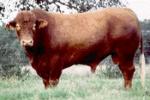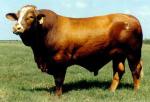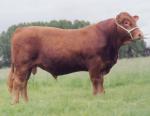|
|

|
Salers
|
|
Drawings of Salers (say Sa'lair) were discovered by archaeologists in cave dwellings dated some 7,000 years ago. The drawings were found near Salers, a small medieval town in the center of France. These drawings and the Salers cattle of today, which are very different from all other French breeds, bear some resemblance to the ancient Egyptian red cattle.
|

|
Santa Cruz
|
|
Santa Cruz cattle represent over ten years of intense research and development by the King Ranch aimed at creating a more market acceptable beef animal that produced superior results as both a feeder and seedstock animal in hot, humid, and unfavorable environments.
|

|
Santa Gertrudis
|
|
Santa Gertrudis were developed on King Ranch to function in hot, humid, and unfavorable environments. The Santa Gertrudis was developed by crossing Indian Brahman cattle with British Shorthorns. In 1920, years of experimentation culminated with the birth of Monkey, a deep red bull calf. Monkey became the foundation sire for not just a superior line of cattle, but an entirely new breed. In 1940, Santa Gertrudis was recognized by the U.S.
|

|
Senepol
|
|
Senepol were developed on the Caribbean Island of St. Croix by Henry C. Nelthropp in the early 1900's by crossing Red Poll cattle and N'Dama cattle. The Senepol breed combines the N'Dama characteristics of heat tolerance and insect resistance with the extreme gentleness, good meat, and high milk production of the Red Poll. He selected for early maturity and maternal efficiency, no horns and solid red color, definite heat tolerance, and gentle disposition.
|

|
Shorthorn
|
|
Shorthorn originated Tees River Valley in the northeastern part of England in the counties of Northumberland, Durham, York and Lincoln. They were brought to America in 1783 and were popular with America's early settlers.
|

|
Simbrah
|
|
An experiment combining Simmental with Brahman that began in the pastures of a few dedicated cattlemen in the late 1960s has evolved logically into the breed called Simbrah. The Brahman or Zebu, the most numerous cattle type on earth, contributes heat and insect tolerance, hardiness and excellent foraging ability, as well as maternal calving ease and longevity.
|

|
Simmental
|
|
Simmental can be traced to the Bernese Oberland, and were known as early as the Middle Ages as large, spotted cattle. From here, the 'Simmentals' spread into western and northern Switzerland.
|

|
South Devon
|
|
South Devon have existed in south-west England for about 400 years. They are believed to have evolved from the large red cattle of Normandy which were imported to England at the time of the Norman invasion. Over 100 years of selection for performance have given the South Devon its outstanding qualities of beef and maternal characteristics.
|
|
|